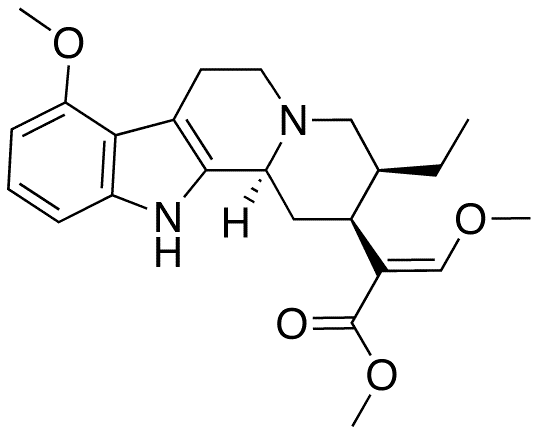Formula C23H30N2O4 | Molar mass 398.4953 g/mol | |
 | ||
Mitragynine is an indole-based opioid and the most abundant active alkaloid in the plant Mitragyna speciosa, commonly known as kratom and biak-biak. Dry kratom leaf contains roughly 1.2–2.1% mitragynine.
Contents
- How to pronounce mitragynine
- Subjective perceptions
- Pharmacology
- Pharmacokinetics
- Detection in body fluids
- Structure
- Synthesis
- References
How to pronounce mitragynine
Subjective perceptions
In spite of the fact that mitragynine has sometimes been touted and used as a “legal opioid,” few scientific studies have addressed the psychoactive properties of mitragynine. Most of the available information is based on anecdotal reports and patient experiences. The general subjective effects of mitragynine have been summarized in various reviews and include improved mood and analgesia, with some subjects experiencing relaxation and others stimulation (paradoxical effects).
Pharmacology
Mitragynine itself acts primarily via μ-opioid receptors, though its oxidation product mitragynine pseudoindoxyl, acts as an even more potent and selective μ-opioid agonist but with less affinity for δ or κ receptors. Another alkaloid with a major contribution to the μ-opioid activity of the kratom plant is the related compound 7-hydroxymitragynine, which, while present in the plant in much smaller quantities than mitragynine, is a much more potent μ-opioid partial agonist. The extent to which this minor but more potent partial mu agonist constituent of the plant contributes to the subjective effects of Kratom consumption is still unclear.
Pharmacokinetics
Mitragynine has been studied in chronic users. It undergoes extensive hepatic metabolism with linear kinetics and long half life.
Detection in body fluids
Blood mitragynine concentrations are expected to be in a range of 10–50 μg/L in persons using the drug recreationally. Detection in body fluids is typically by liquid chromatography-mass spectrometry.
Structure
It is structurally related to both the yohimbe alkaloids and, more distantly, voacangine. Chemically, mitragynine is 9-methoxy-corynantheidine.
Synthesis
The first total synthesis of mitragynine was reported by Takayama et al. in 1995.
